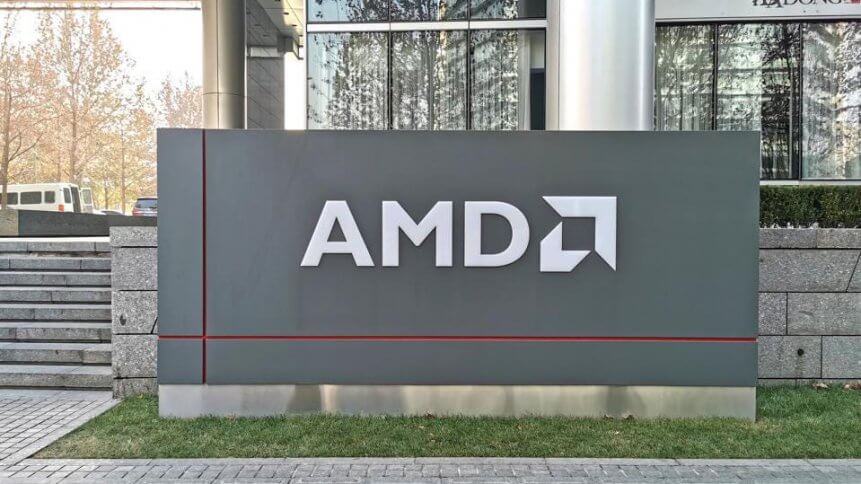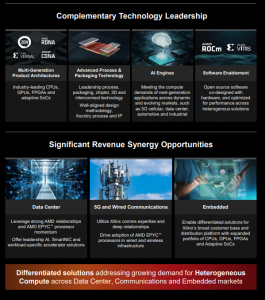What does the US$50b deal of AMD, Xilinx mean to the chip industry?

- With the Xilinx acquisition, AMD will be able to increase its breadth in key markets like data centers where Xilinx has a strong network.
- It will be beneficial for AMD’s AI presence as well as in the 5G communications, automotive, industrial, aerospace and defense markets.
- The combined company will have more than 15,000 engineers and a completely outsourced manufacturing strategy that relies heavily on TSMC.
In October 2020, Advanced Micro Devices Inc or more commonly known as AMD inked a US$35 billion deal to buy Xilinx Inc., a maker of programmable chips used in systems ranging from data center servers to satellites. The deal was made to buy AMD a foothold in many parts of the chip market where it currently doesn’t have as big a presence, especially the data center segment.
Some 16 months later, the deal finally went through and AMD, a semiconductor designer purchased Xilinx for US$50 billion, a record chip industry deal. The transaction, considered as the biggest in AMD’s history, met all the various regulatory approval it needed to happen.
According to Reuters, the deal’s value climbed to about US$50 billion from US$35 billion because AMD’s share price increased substantially since the acquisition was first announced. Coincidentally, the closing of the deal comes on the heels with Nvidia Corp’s decision to abandon its plans to buy SoftBank-owned Arm Ltd–it was meant to be the biggest semiconductor merger of all time.
What would this deal mean for AMD and Xilinx?

AMD Strategic Acquisition of Xilinx. Source: AMD
AMD’s CEO Lisa Su told Reuters that between AMD’s processor technologies and Xilinx’s system on chips and field programmable chips, the two businesses are complementary. “That was our focus in talking to the regulatory authorities across the world,” Su said, adding that Arm was an important partner for AMD but declined to say more about Arm’s possible next steps.
Additionally, with the Xilinx acquisition, Su said AMD will be able to increase its breadth in key markets like data centers where Xilinx has a strong network and AI presence, as well as in the 5G communications, automotive, industrial, aerospace and defense markets. “Those are all markets that AMD has had very little presence in and they all need high performance computing as well,” she added.
YOU MIGHT LIKE

AMD strikes chip deal to power Meta’s data centers
Besides the Field Programmable Gate Arrays (FPGAs) for which it’s best known, Xilinx also makes chips that are used to power 5G cell towers. It is coincidentally an area where AMD rival Intel Corp. has also sought to increase its presence. Intel in 2020 introduced several processors with specialized networking features designed for carriers.
“The acquisition of Xilinx brings together a highly complementary set of products, customers and markets combined with differentiated IP and world-class talent to create the industry’s high-performance and adaptive computing leader. Xilinx offers industry-leading FPGAs, adaptive SoCs, AI engines and software expertise that enable AMD to offer the strongest portfolio of high-performance and adaptive computing solutions in the industry, ”Su said in a statement.
Since the acquisition is complete, AMD said it is turning the chipmaker into a new business unit dubbed the Adaptive and Embedded Computing Group, or AECG for short. The unit will be led by former Xilinx CEO Victor Peng. The combined company has more than 15,000 engineers and a total addressable market that is expected to reach US$135 billion next year, Su stated.






![Competing with the long-running Intel vs AMD vs Nvidia central processors rivalry, Amazon came out with its 3rd-gen Graviton chip and Trn1 AWS claims the new chipsets will help customers significantly improve performance, cost, and energy efficiency [see_also_flex pos='left' post_id='206950'] When Amazon acquired Annapurna Labs in 2016, the tech giant was seriously evaluating to build custom chips for its cloud infrastructure services, to give it an edge against its arch-rivals, Microsoft and Google. Today, the company has two new custom chips that would give Intel Corp, Nvidia Corp and Advanced Micro Devices (AMD) a run for their money. At its re:Invent 2021 conference yesterday, Amazon unveiled the Graviton3 and Trn1 chipsets. The former is basically the next generation of its custom ARM-based chip for artificial intelligence (AI) inferencing applications while Trn1 is a new instance for training deep learning models in the cloud. Amazon Web Services (AWS) CEO Adam Selipsky said during his keynote address that his market-leading public cloud company is focused on "making the full power of machine learning available for all customers. Lowering the cost of training and inference are major steps of the journey." AWS vs Intel vs AMD vs Nvidia The third generation of Graviton will soon be made available in AWC’s C7g instances, the company said, adding that the processors are optimized for workloads including high-performance computing, batch processing, media encoding, scientific modeling, ad serving, and distributed analytics. Selipsky says that Graviton3 is up to 25% faster for general-computer workload and provides two times faster floating-point performance for scientific workloads, two times faster performance for cryptographic workloads, and three times faster performance for machine learning workloads versus Graviton2. To top it off, Graviton3 uses up to 60% less energy for the same performance compared with the previous generation, Selipsky claims. Amazon’s vice president of Elastic Compute Cloud Dave Brown told Reuters that the company expects it to provide a better performance per dollar than Intel's chips. To top it off, AWS still works closely with Intel, AMD, and Nvidia and Brown said AWS wants to keep the computing market competitive by offering an additional chip choice. [see_also_flex pos='wide' post_id='208827'] Graviton3 and Trn1 According to Selipsky, Trn1 will be Amazon’s instance for machine learning training, delivering up to 800Gbps of networking and bandwidth, making it well-suited for large-scale, multi-node distributed training use cases. Customers can leverage up to tens of thousands of clusters of Trn1 instances for training models containing upwards of trillions of parameters. As per reports online, Trn1 supports popular frameworks including Google’s TensorFlow, Facebook’s PyTorch, and MxNet and uses the same Neuron SDK as Inferentia, the company’s cloud-hosted chip for machine learning inference. Amazon is quoting 30% higher throughput and 45% lower cost-per-inference compared with the standard AWS GPU instances](https://techhq.com/wp-content/uploads/2021/12/185050-untitled-design-4-150x150.jpg)


